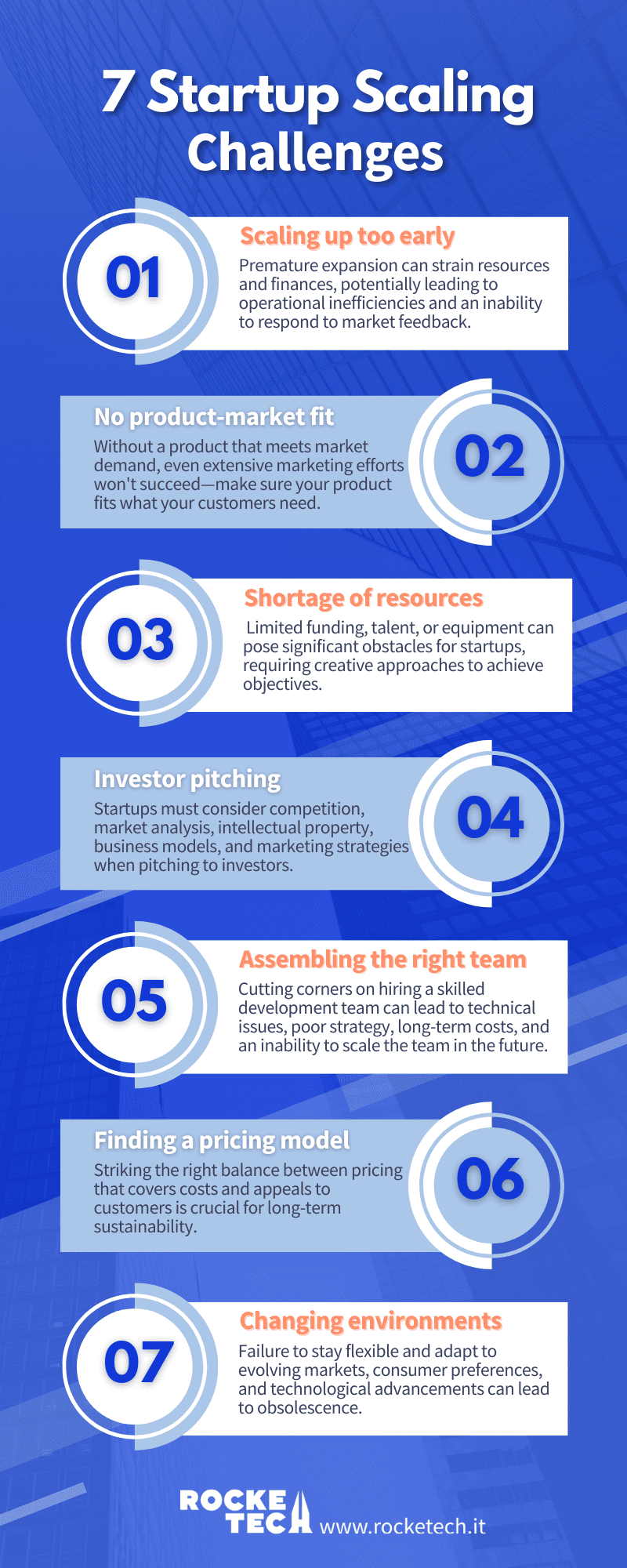Pretty much every startup founder wishes for their product to become the next Uber, Airbnb, or Slack. While launching is already a huge challenge, many startupers forget about startup scaling. At some point, the journey turns into a monumental, long-term project that becomes too difficult to handle.
What do startups need to know about further stages? We summed up the most common pitfalls in our guide.

Growth vs Scaling
In the world of startups, two buzzwords that frequently dance across boardroom tables and coffee shop conversations — “growth” and “scaling.” These concepts, while seemingly interchangeable, are distinct forces that can steer your entrepreneurial ship in vastly different directions. Here’s why.
Let’s start with growth. Think of it like a small plant turning into a bigger one. Growth means slowly getting better at your startup. You might get more customers, make more money, or sell more stuff, step by step.
For example, imagine you run a little brewery. You’re growing if more people are coming to taste your beer, and maybe you open another spot in a nearby town. It’s like taking small steps forward.
Scaling, on the other hand, is like turbocharging your startup. Scaling means making your business much, much bigger without spending tons more money. It’s like finding a magic button to make things explode in a good way.
Back to the brewery example, scaling is when you start selling your beer all over the country, making more beer with fancy machines, and earning way more money without going broke.

So, growth is about slow and steady progress, and scaling is about supercharging your business. First, you need to grow, like a baby learning to walk, and then when you’re ready, you can aim for the stars and scale up big time.
Is It Time to Scale Up the Company?
Choosing the right moment to get to another level is an art of some sort. Scaling up too soon can lead to disaster, but waiting too long can mean missed opportunities. There’s no simple and universal answer to “When?”. However, these four beacon questions can help startup founders make better decisions.
- Is there potential demand in the future?
Are there clear signs that your product or service will be in even greater demand in the future?
It’s not just about what’s popular now; it’s about understanding trends and staying ahead of the curve. Scaling up should align with your ability to meet this growing demand.
- Has the startup achieved a positive cash flow?
Is your startup making more money than it’s spending? Have all your pending payments been recovered?
Positive cash flow means you’re financially stable and can cover your expenses while having some left for growth. Scaling up without this financial foundation is like building a castle on shifting sands.
- Is your startup using the right tech?
Do you have technology that can handle increased workload as you scale up?
Up-to-date and efficient technology is the backbone of modern business. Ensure your startup is equipped with the right digital arsenal to handle increased operations.
- Is your startup backed up by the right team?
Do you have a team that can execute your expansion plans effectively? Is team scaling something you can effectively do soon?
Growth often requires more hands on deck, but it’s not just about numbers. It’s about having the right people with the skills and dedication to help your startup thrive.
If you are positive about these four critical points, you might be in a good place to start planning the expansion.
7 Startup Scaling Challenges
Here you are, ready to take your startup to a new level and go beyond the horizon. And that’s where many founders stumble. In reality, running a startup is like running two businesses simultaneously. On the one hand, it’s about finding the money to get you up and running. But meanwhile, you also have to operate your company’s sophisticated organism.
Essentially, meticulous planning can help you secure the best possible outcomes. And a huge part of proper planning is predicting the pitfalls awaiting on the way and negating them accordingly. Here are the seven most common challenges startups face while scaling.

#1 Scaling Up Too Early
Scaling up too soon is like a chef opening a restaurant before perfecting the recipes. Premature expansion can stretch your resources thin and lead to financial strain. For instance, an e-commerce startup may be tempted to diversify into multiple product categories without establishing a loyal customer base for its initial offerings. This can result in high operational costs and limited revenue, jeopardizing the entire venture.
Or imagine a software startup with a groundbreaking product that decides to launch in multiple international markets without adequately testing its product’s viability in the home market. The result may be inefficient operations, heavy financial burdens, and an inability to respond to market feedback effectively.
#2 No Product-Market Fit
Many startup founders develop a mythical idea into a business venture without even checking if people need their product. In most cases, hypothetical ideas in our heads have very little to do with the market reality. If your product doesn’t offer enough value to the end customer, even the most expensive advertising and best marketing experts won’t help — the product simply doesn’t have the target audience.
Picture designing a car with square wheels. It may be a great car, but it won’t work well on the road. Startups need to find the right “fit” between their product or service and the market. If an app for senior citizens offers features more suited to teenagers, it won’t gain traction despite being well-made.
#3 Shortage of Resources
Imagine an architect tasked with designing a skyscraper but provided with only a handful of bricks. Startups encountering resource shortages, such as funding, talent, or equipment, face immense hurdles. For example, a biotech startup aiming to develop groundbreaking pharmaceuticals may struggle if it lacks funding to conduct clinical trials or hire experienced researchers.
The irony here is that most startups set sail with extremely limited resources. So, when founders are kickstarting their businesses, it’s really important to get a bit imaginative in how they go about achieving their objectives. Whether that means promoting a product to the masses, grabbing the media and public’s interest, or establishing a solid brand presence in this cutthroat business world, creativity is key.
#4 Investor Pitching
Startups and investors tend to look at projects from different angles. Startups usually focus on the idea, while investors are more concerned with execution and the impact it generates. Entrepreneurs often get caught up in thinking about their product and its unique features, sometimes overlooking the essential principles of building a business and presenting their product for investment.
A strong investor presentation isn’t just about project details written by technical teams. It also needs a deep look at competitors and the market, detailed plans for product development and manufacturing, safeguarding intellectual property, forming a workable business model, and crafting a smart marketing strategy.
Many founders pitch sponsors with just “genius ideas of the century” that often have little to no investment potential. Naturally, such applications are mostly rejected.
#5 Assembling the Right Team
Here’s one quite common scenario. Startup founders have a brilliant idea, tons of motivation, and a tight budget. They decide to cut the budget on hiring a proper development team, thinking that the first, done-somehow product version is OK for a while and can be redone (perfected, improved, you name it) at later stages when they have enough money. Well, it’s wrong.
Assembling a few “cheap” freelancers to build the foundation of your software product poses many risks that will eventually cost you an arm and a leg, from technical debt and badly written code to the wrong overall strategy. Scaling engineering teams is only possible if you start right.
#6 Finding a Pricing Model
Pricing is a big deal, especially when you start in a new market. You don’t want to make your price too low because that makes your product seem not so appealing and cheap. But you also don’t want it so high that people can’t afford it.
Many startups struggle to find a price that’s high enough to cover their costs and make some profit. Having a low profit might help sell more at first but won’t work in the long run. As time goes on, your expenses will go up, and you’ll need more profit to keep going.
#7 Changing environments
Failing to adapt to a dynamic market is like navigating a complex maze with a map frozen in time. Today, change is constant, and startups must embrace this reality.
Imagine a traditional retail chain steadfastly clinging to brick-and-mortar stores while e-commerce continues rising. Such resistance to change can lead to dwindling sales as consumers increasingly turn to online shopping, ultimately resulting in the retail chain’s obsolescence.
Market dynamics evolve, consumer preferences shift, and technological advancements redefine industries. For some business owners, it becomes an ultimate challenge to stay flexible and anticipate the changes in their customers’ behavior.
How to Scale Up and Survive
The short answer is to plan carefully, create a strong team, and keep testing. Here are the three insights in more detail.
Build the Operations
Startup scaling is more likely to become successful if you understand the mechanisms of expansion. There are different versions of a startup lifecycle. Let’s take the one that explains what happens when you decide to scale your team.
- Stage One: Creative Beginnings
At the start, founders juggle many roles, from conceiving the idea to handling marketing and finances. This is when the team goes from one to ten members, fueled by creativity and testing ideas to find their market and secure funding. It’s the foundation-building phase.
- Stage Two: Building Operations
As the startup grows to 10–100 employees, the focus shifts to creating a strong operational system. The original team evolves into capable leaders who build and manage their own teams. This phase emphasizes resource allocation, maintaining quality, and refining communication. Clear communication tools and HR systems support remote workforces. The goal is to establish a responsible organization with lasting values and culture.
- Stage Three: Strategic Growth
In the 100–1000 employee range, the startup enters a phase of strategic scaling, akin to a chain restaurant with automated processes and quality control. The operational system should be impeccable, allowing experienced staff more freedom. Armed with market knowledge, the startup expands confidently. Cost-cutting methods from earlier stages enable scaling without constant innovation.
Build the Foundational Team
Starting with the right team is more significant than many founders think. As mentioned above, building the first product version with just anyone available around will most likely turn into a costly mistake.
Partnering with experienced professionals will help you avoid many potential problems in the future. Put simply, experts suggest tech stacks that will stay relevant and easy to maintain. A good dev team writes clean code and, most importantly, preserves your intellectual property and project expertise inside your product.
Keep Testing
Some of our clients are serial entrepreneurs. They come up with multiple ideas and need ways to test them quickly and efficiently. Launching a minimum viable product (MVP) is the proven way to validate your hypothesis with real people in actual market environments.
We believe that development only starts with the product launch. While proper planning is vital, running hypothetical scenarios won’t bring tangible results. The moment you make your product available to your target audience is when you face the reality. Customer feedback and behavior help you adjust your strategy accordingly and make the product people actually are willing to pay for.
Final Thoughts
By the time startup founders get the desired funds, the investors will expect them to have already established operations and understand the meaning of startup management principles. Whether it’s your flexibility, perfected business model, or tech teams scaling approaches, most likely, you’ll face many challenges in this journey.
We can help.